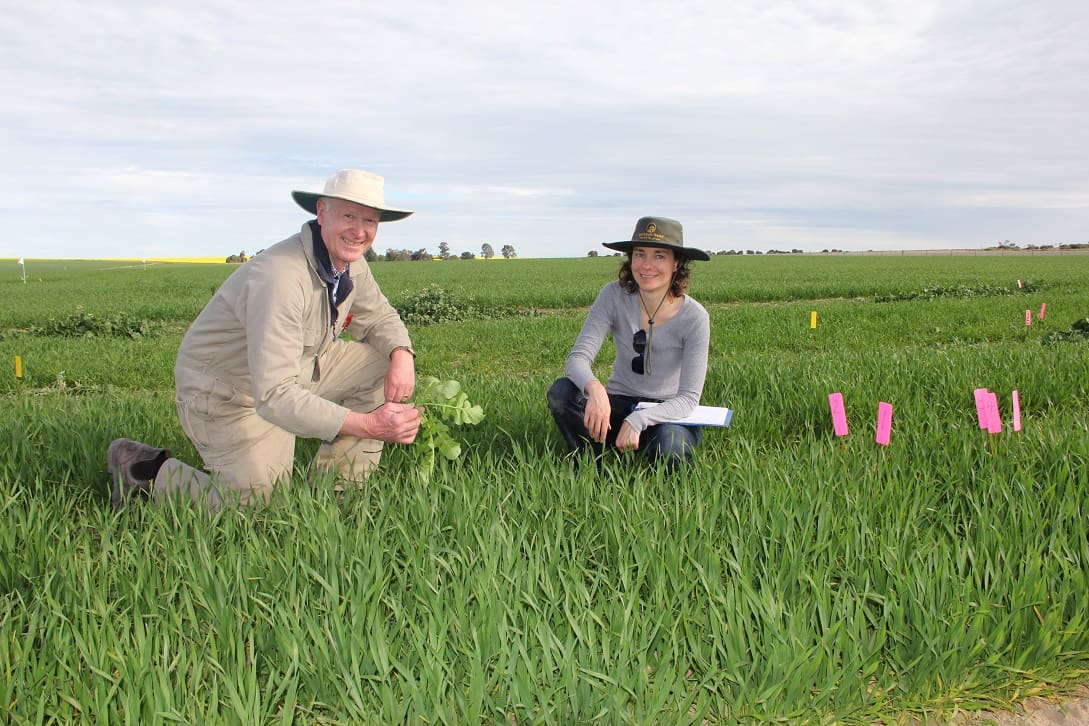
DPIRD research scientists Glen Riethmuller and Dr Catherine Borger examine crop-competition in a weed trial at the department’s Wongan Hills Research Facility.
THE behaviour of weeds has changed significantly in Western Australia over the past three decades, which has resulted in the increased emergence of minor weeds.
The WA Department of Primary Industries and Regional Development (DPIRD) is examining the biology of 10 emerging weed species in the grainbelt that threaten crop productivity and profitability to improve integrated weed management strategies.
The research is part of a University of Adelaide led project with co-investment from the Grains Research and Development Corporation.
DPIRD research scientist Catherine Borger said the research provided new information about the ecology of great brome, barley grass, doublegee, sowthistle, wireweed, windmill grass, roly poly, caltrop, Afghan melon and button grass.
“While most of these weeds have been around for more than 100 years, their impact has increased in the past 10 years or so, since the advent of minimum tillage farming systems, herbicide resistance, continuous cropping and a changing climate,” Dr Borger said.
“This project aims to generate a better understanding of the seed bank biology of these weeds, including seed dormancy, seed bank persistence, the timing of seed shedding and competitiveness within crops.
“This knowledge will help develop integrated weed management strategies that growers can then tailor to their farming system to increase yields, as well as reduce control costs and contamination, which can impact on market access.”
Field experiments and laboratory studies were undertaken in WA as part of the five-year project, which in addition to the University of Adelaide involves the University of Queensland and New South Wales Department of Primary Industries.
Five years of research show that a changing climate is having a significant influence on the emergence of these weeds.
“The research shows both winter-spring and summer weeds can germinate in late winter and spring – given adequate moisture – and that increasing November rainfall results in summer weed emergence,” Dr Borger said.
“It is clear the management of both winter and summer weeds in November is becoming an issue, which could be challenging, as there are few herbicide options available in mature crops prior to harvest.”
A comparison of the 10 emerging weeds in competition with grain crops found that great brome was the most competitive, followed by barley grass, sowthistle, doublegee and wireweed.
“To avoid yield loss in a low yield potential season with a less competitive crop, great brome and barley grass, in particular, need to be controlled in-crop,” Dr Borger said.
“It is likely that the late, staggered emergence of sowthistle, doublegee and wireweed and the prostrate growth of doublegee and wireweed reduced the competitive ability of these species.”
The research findings have been valuable to update the national Weed Seed Wizard online tool, used to predict weed emergence and crop yield losses and plan integrated weed management programs.
“To give an example, the time of seed shedding for species like great brome and barley grass was highly variable between seasons and populations,” Dr Borger said.
“In spite of the variable shedding times for these grass weeds, the model highlighted how valuable harvest weed seed control was for weed control, even if you can only remove a small proportion of the seeds produced each year.”
Source: DPIRD



HAVE YOUR SAY